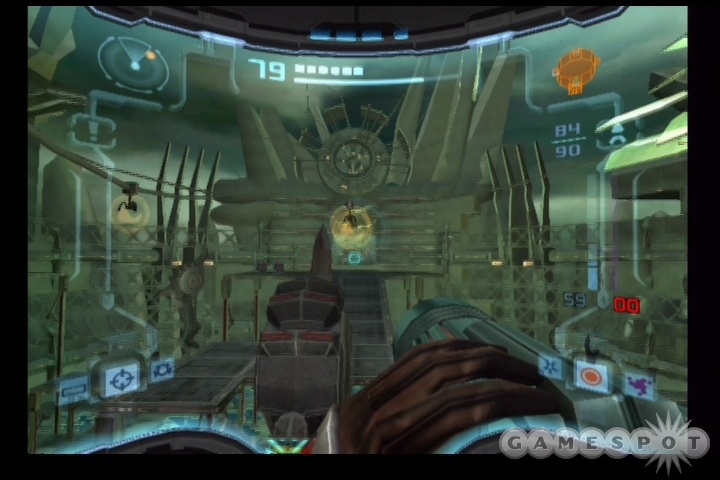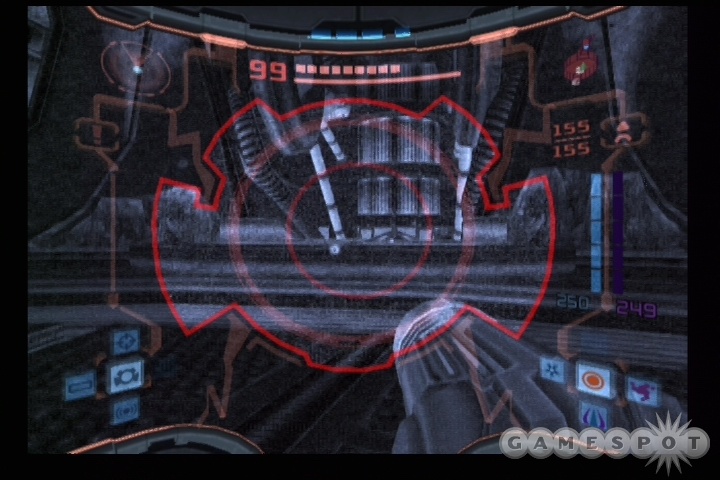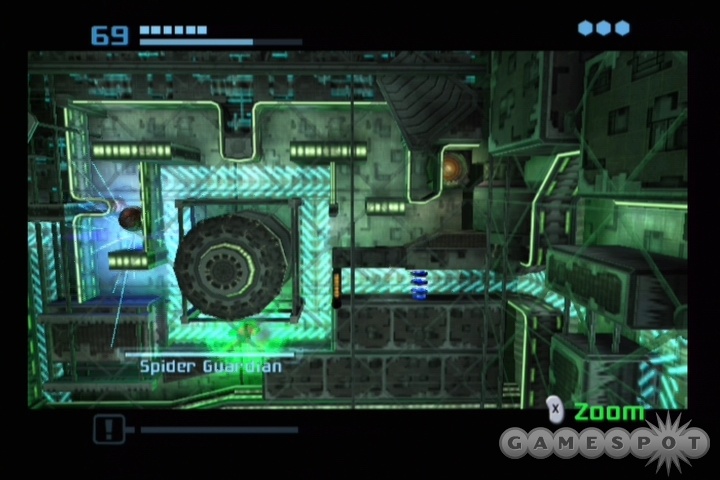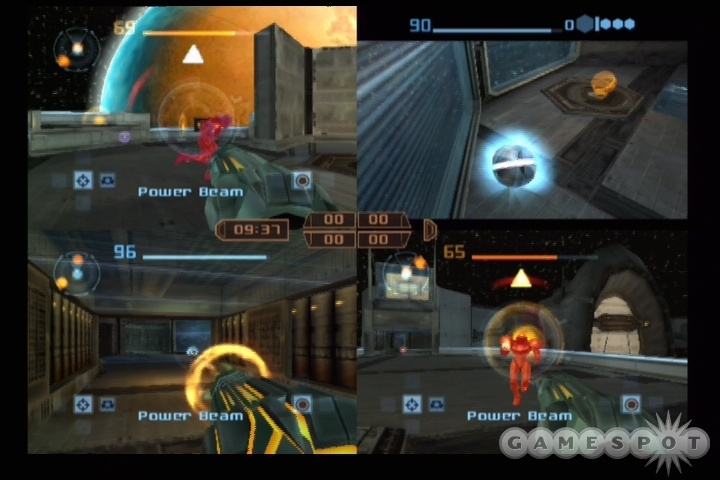It was only two years ago that an upstart Texas developer named Retro Studios allayed an industry's worth of skepticism by delivering Metroid Prime, a sublimely rendered 3D take on Nintendo's beloved sci-fi adventure series. That game defied many gamers' expectations--it more accurately re-created, from a first-person perspective, the moody, exploration-based shooting action of past Metroid games than many doubting nostalgists thought possible. Prime was, in essence, an unexpected and unadulterated success. In the last two years, Retro has perfected and evolved the form of its previous game to bring us Metroid Prime 2: Echoes, a sequel that takes the established framework and builds on it with diverse new locales, innovative abilities, and inventive gameplay. Despite the addition of a middling and somewhat unnecessary multiplayer component, Echoes stands shoulder to shoulder with its predecessor, delivering absolutely everything you'd want from a new 3D Metroid adventure.

The game begins simply enough, placing you once again in the hefty cybernetic boots of noble interstellar bounty hunter Samus Aran. Following a simple Galactic Federation directive to investigate a missing squad of troops, Samus tracks a signal to the remote planet Aether and descends to the surface to find the missing detachment. From here things become anything but simple. Within minutes, you'll find yourself being drawn into a bizarre civil war between the luminoth, a benevolent, mothlike race that inhabits Aether, and the ing, a vile host of dark creatures who reside in an alternate-reality version of the planet referred to as Dark Aether. The ing have a nasty habit of popping into the light version of Aether at will to possess other beings, which you'll discover early on. And wouldn't you know it--your old friends the space pirates are also on Aether, working to further their nefarious ends. Soon, the mission to discover the missing soldiers is replaced by a battle to defeat the ing and destroy Dark Aether, restoring the once-tranquil planet back to the beleaguered luminoth. To top everything else off, there's a dark and seemingly malevolent version of Samus running around, causing havoc for everyone. Our favorite bounty hunter certainly has her hands full here.
Retro has done an outstanding job of bringing Aether's opposing halves to life. The light side is full of organically designed, varied environments ranging from arid wastelands to rain-soaked marshes to a stunning futuristic fortress located high up in the mountains. Dark Aether, on the other hand, is a hellish, twisted mirror image of the light world, with a generally identical layout and much of the same actual topography. The relationship is actually quite similar to the one in another Nintendo game, The Legend of Zelda: A Link to the Past on the Super NES. Like in that game, you'll travel back and forth between worlds using portals scattered around the map, and many of your actions in one dimension will have specific effects in the other. Dark Aether engenders a truly ominous sense of mood, with its predominantly dark-purple color palette and grotesque denizens. The atmosphere itself is caustic to Samus early on and rapidly bleeds your energy away, forcing you to seek refuge in small protective bubbles of light energy, which really helps establish palpable tension while you're forging ahead in the dark world.
For a Metroid game, Echoes goes to pretty impressive lengths to develop its storyline, though like its predecessor, most of the plot development comes through the discovery of textual logs and ancient lore. You'll find the relics--and the corpses--of the luminoth and ing war scattered liberally throughout the world, and these provide both interesting backstory and valuable information to help move you along. Despite the presence of so many factions--the Galactic Federation marines, the space pirates, the luminoth, and the ing--you'll rarely interact with friendly characters throughout the game, so Echoes effectively re-creates the feeling of solitude in an alien world that's so integral to the Metroid experience.

If you've played Metroid Prime, you've essentially played Metroid Prime 2. Retro hasn't mucked with the original, winning formula, so veterans of the first game will feel quite at home resuming their position behind Samus' computer-enhanced visor. The heads-up display, in fact, really hasn't changed at all--you're literally seeing through the eyes of Samus, viewing readouts on the curved inside of her helmet. Nor have the controls, for that matter. You can still lock on to enemies and relevant background elements, which makes aiming a nonissue and frees you up to concentrate on exploring the enormous, complex environments. Samus' trusty scan visor once again comes in handy--you'll automatically scan every new room you enter to gather valuable clues about your surroundings and also discover new elements of the intriguing story.
Echoes dispenses with some of the standard Metroid equipment that fans have come to know and love, most noticeably the ice and wave beams and the X-ray and thermal visors from the original Prime. It's hard to miss that stuff, though, when you get a load of all the new toys that the sequel offers. In addition to the trusty charge cannon, you'll soon receive the light beam and the dark beam, two weapons that naturally tie into the light-and-dark theme of Aether's opposing dimensions. Many of the game's enemies are light- or dark-aligned, so you'll be able to use the weapon with opposite properties to deal extra damage. Furthermore, there are a lot of puzzle-oriented scenarios in both dimensions in which the ability to wield light and dark energy comes in handy. Later in the game, you'll obtain the annihilator beam, a weapon that combines both light and dark energies and has its own specific uses. If you've played previous Metroid games, you may be a little surprised that the three secondary beams have limited ammo, which requires you to use them judiciously and rely on your standard charge beam fairly often. Of course, Samus' impressive array of equipment doesn't consist of just guns, and Echoes delivers a host of useful secondary equipment as well.
The visor system was an innovative addition in Metroid Prime, allowing you to see in a number of different spectrums and consequently facilitating plenty of new puzzle opportunities. In addition to the standard combat and scan visors, Echoes gives you the dark visor and the echo visor, each accompanied by nifty visual filters and unique properties. The dark visor lets you see more clearly in Dark Aether and also makes interdimensional items and enemies show up in bright red. The echo visor literally lets you see in terms of sound, acting as a sort of sonar overlaid on the environment and allowing you to interface with sonic locking mechanisms. Again, these new visors allow for some ingeniously tricky puzzles.

Of course, it wouldn't be Metroid if Samus didn't have missiles, bombs, super missiles, power bombs, and the ever-present morph ball, and those are all included as well. There's even a new seeker-missile ability that lets you paint up to five targets and then launch missiles to strike them all simultaneously. Lots of new and old Metroid equipment is here as well. The grapple beam returns, allowing you to swing over wide chasms. The spider ball again comes in handy for rolling up walls in ball form, and the newly revived screw attack lets you perform multiple flips in midair to damage enemies and traverse large distances. In true Metroid form, you'll come under attack right at the beginning of the game and be forced to recover all this equipment as you trudge onward toward your confrontation with the despicable ing leadership.
Recovering that equipment, discovering new areas, and battling vicious enemies are as devilishly challenging and as rewarding in Echoes as they have been in every other Metroid game. With the host of new equipment and the two dimensions of Aether at their disposal, Retro's designers had an absolute field day dreaming up complex environments and puzzles for you to discover and solve. You'll hop through portals between worlds more times than you can count, scanning with every visor, bombing in every corner, and generally turning the world upside down to find the next available path--and even when you're banging your head against a wall, you'll have a great time just traversing the lush environments, looking for clues.
With the exception of a strange sort of scavenger hunt in the endgame, the objectives in Echoes proceed with the series' trademark fluidity. The acquisition of one item will instantly open up half a dozen new areas for you to explore, leading you to even more discoveries--just like Metroid has always worked. That one questionable sequence at the end of the game may serve as a sort of brick wall for less-stalwart players, unfortunately--it requires you to cross-reference luminoth logs and lore with map locations in both dimensions and with previously acquired items. This section is certainly manageable with a bit of diehard sleuthing, but it's also a little too obscure for its own good. At least there's an automatic hint system, similar to the one in the first game, that kicks in and guides you to the next hidden objective if you flounder around for too long. Purists will be glad to know that this feature can be disabled, so you can go at it without any help whatsoever if you want.
When developing the first Metroid Prime, Retro must have expended considerable energy simply nailing the Metroid experience in full 3D. Now that the framework is set, the designers have been able to craft some really impressive new gameplay around the basic model. For instance, you'll fight one boss entirely in morph-ball mode from the standard cutaway side view, which requires you to execute precision-bombing tactics to defeat the boss without sustaining damage yourself. Other boss encounters make interesting use of your standard equipment, such as the spider ball, providing a lot of truly impressive moments when you finally realize the proper method for defeating the enemy. All the way up to the very last boss, you're constantly being challenged to consider the immense amount of equipment at your disposal and determine the proper method for surmounting a given challenge.
Echoes looks better than Metroid Prime, but you might have to compare them side by side before that's apparent. The differences are subtle and perhaps made even less obvious by the fact that several elements of the two games' presentations--everything from the HUD to the pop-up info windows and many of the accompanying sound effects--are basically identical. But the environments and even Samus herself are more-detailed this time around, boasting greater geometric detail, more-dynamic designs, and impressive new lighting and other special effects. The world of Aether is brought to life with exceptional artistry--no two areas look even remotely the same, and they all feature inventive architecture and unique set pieces. The designs for the ing are especially ghastly, putting a repulsive face on your new enemy. And just like its predecessor, the game runs at a perfectly smooth frame rate, which is all the more impressive considering how good it looks. The sound design is excellent (though much of it is the same as in the original game), with the many weapons and enemies underscored by appropriate aural accompaniment. Prime 2's soundtrack also does a great job of establishing mood without being obtrusive, though it's not the kind of thing you'll be humming in the shower.

Strangely, Echoes has a multiplayer component with a handful of maps for up to four players, but it's unfortunately not up to the single-player game's quality and seems a little incongruous with the solitary, adventure-driven spirit of the Metroid series. Two basic modes are on offer: the self-explanatory deathmatch mode, and the bounty mode, which makes wounded players bleed coins (and slain ones bleed more), with the objective being to hit the coin limit before your competitors. The multiplayer mode grafts the beams and some of the equipment from the single-player game onto a rudimentary power-up model, and the lock-on system works reasonably well in a competitive format--you can switch to morph ball and hit your boost to break a lock--but overall the feel of the multiplayer isn't nearly as solid as in shooters with an actual multiplayer focus. It's not hard to imagine that this competitive mode was shoehorned into the game due to the widely held expectation that all first-person games--and most GameCube games, for that matter--should have some kind of multiplayer, as it feels a little half-baked and out of place here. The good news is that Echoes doesn't suffer at all for having this mode (nobody's making you play it, after all), and it would be just as great an overall package if the multiplayer hadn't been included.
If you finished Metroid Prime and were left wanting more, Echoes gives it to you in spades. Anyone who was turned off by the slowly paced and meticulous exploration elements of the original game won't find anything new to win them over here--a run-and-gun shooter this ain't. The game is quite long and involved--you'll spend a bare minimum of 20 hours just getting to the end, and finding all the hidden items and scanning everything will take much longer (and will open up bonuses such as a harder difficulty mode and production-artwork galleries). As an adventure game with heavy action elements and an emphasis on complex puzzle-solving, Metroid Prime 2 is about as good as it gets, on the GameCube or on any platform.